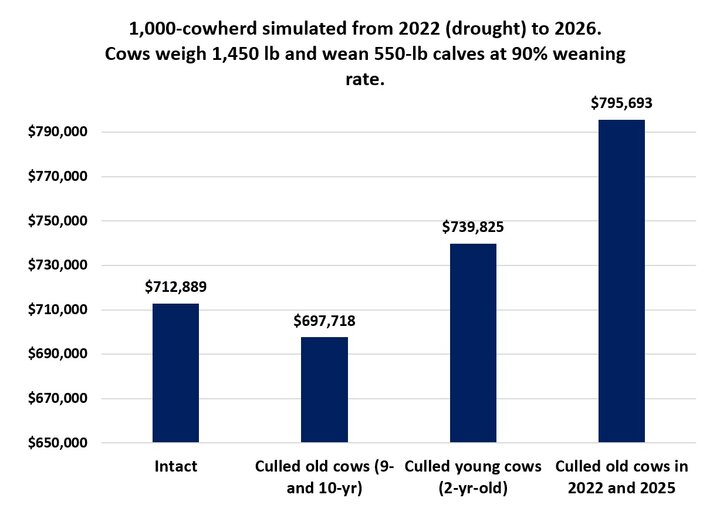The US drought monitor is indicating that drought conditions for central states, including Nebraska, remain in 2022. Seasonal outlook for the remainder of summer in Nebraska and western states is characterized as drought tendent. Persistent drought pressured forage and grain prices and deteriorated pasture conditions. Concurrently, the January US beef cow inventory declined from a peak in 2017 of 31.2 million cows to 30.1 million cows in January of this year. Implications of lower beef cow inventory on supply of feeder calves are already evident in the marketplace: feeder cattle prices increased from an average of $155/cwt for a 550-lb calf in the fall of 2020 to $172/cwt in the fall of 2021. This trend has continued to date.
Under the prevailing threat of drought for the remainder of 2022, cow-calf producers may face a difficult decision—to cull some or all cows from their cowherd or to consider placing some or all their cows in a drylot (owned or custom). Reducing herd size as better feeder prices return could put producers at risk of missing this opportunity.
Using a production model that permits evaluation of biologic (cow and calf age), weather and economic factors on performance and net return, three culling strategies for a 1,000-cow herd, in response to drought and/or high feed prices in 2022, were considered: no culling, culling all 9- and 10-year-old cows (111 old cows) or culling all 2-year-old cows (134 young cows) on the fifth month since calving. A herd projected with a weaning rate of 90% achieving 550 lb weaning/calf was run through the model for five consecutive years (2022 to 2026). Heifers were held at a rate to replace cows not weaning a calf regardless of drought-culling strategy. Effects of drought on calf growth were modeled so that projected weaning weight was not achieved in the 2022 projection. Calf and cull cow price trends were derived from trends observed for the years 2012 to 2016 using projected fall calf ($188/cwt) and cull cow ($75/cwt) prices in 2022. A $10/cwt price slide was applied based on a 550-lb calf. It is important to note that these trends were positive starting in 2012 but declined rapidly in 2016. Relative to 2025, 2026 feeder price was projected to be $62.53/cwt less. Annual cow cost was assumed to be $1,040/cow for the duration of the simulation and adjusted accordingly when herd size changed.
Figure 1 depicts cumulative (5-year) net return in response to these simulations. Cumulative net return was greatest when young cows were culled in 2022 ($26,935 more than keeping herd size intact). Culling young cows should be given careful consideration: A potential gain of $5/cow/year on net return may not be worth the loss in genetic progress represented by culling young cows.
Culling old cows returned $15,171 less in five years than keeping herd size intact. When prorated by year and herd size, this exercise demonstrates that choosing to reduce herd size in 2022 by culling old cows to cope with drought has relatively little impact ($3/cow/year) on 5-year cumulative return outlook. This is because keeping the herd intact during the projected lower feeder prices in 2026 will result in projected net losses of $160,000; projected net losses of herds simulated to cull old or young cows in 2022 were offset by fewer cows in 2026 and selling cull cows at a relatively high price in 2022.

Replacing old or young cows culled in 2022 was not a good option (results not plotted). Investments in pregnant replacements incurred in early 2023 are likely to be high (modeled here at $1,750/cow) and further exacerbate negative effects of feeder price drop projected for 2026.
Because the projected feeder (and cull cow) price drop influenced net return markedly, a curious alternative was simulated: culling old cows in 2022 and culling old cows again in 2025 (after a 214-day lactation). This strategy generated a net reduction in the herd of 111 cows in 2022 and 99 in 2025; but it also led to the greatest projected cumulative 5-year net return ($795,693). This projection is equivalent to a difference of $82,804 between the no-cull strategy and the double-cull strategy and represents an additional annualized return of nearly $16,600. Some of this cash may be used to cope with high feed prices in 2022.
Interviews with the authors of BeefWatch newsletter articles become available throughout the month of publication and are accessible at https://go.unl.edu/podcast.
Topics covered:
Marketing, budgets & management, Budgets & cost of production, Marketing & risk management, Nutrition, Genetics & selection, Selection & culling, Weather, Drought

